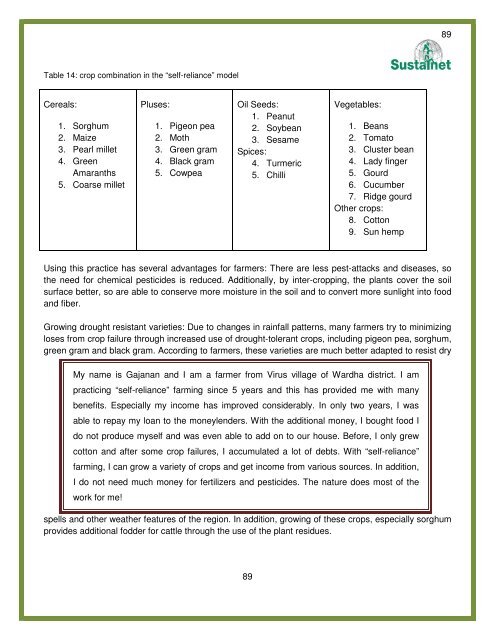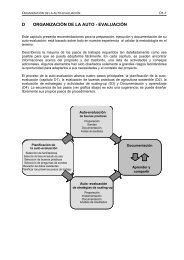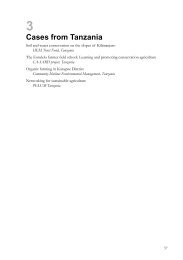Adaptation of small scale farmers to climatic risks in India - Sustainet
Adaptation of small scale farmers to climatic risks in India - Sustainet
Adaptation of small scale farmers to climatic risks in India - Sustainet
You also want an ePaper? Increase the reach of your titles
YUMPU automatically turns print PDFs into web optimized ePapers that Google loves.
Table 14: crop comb<strong>in</strong>ation <strong>in</strong> the “self-reliance” model<br />
Cereals:<br />
1. Sorghum<br />
2. Maize<br />
3. Pearl millet<br />
4. Green<br />
Amaranths<br />
5. Coarse millet<br />
Pluses:<br />
1. Pigeon pea<br />
2. Moth<br />
3. Green gram<br />
4. Black gram<br />
5. Cowpea<br />
Oil Seeds:<br />
1. Peanut<br />
2. Soybean<br />
3. Sesame<br />
Spices:<br />
4. Turmeric<br />
5. Chilli<br />
89<br />
Vegetables:<br />
1. Beans<br />
2. Toma<strong>to</strong><br />
3. Cluster bean<br />
4. Lady f<strong>in</strong>ger<br />
5. Gourd<br />
6. Cucumber<br />
7. Ridge gourd<br />
Other crops:<br />
8. Cot<strong>to</strong>n<br />
9. Sun hemp<br />
Us<strong>in</strong>g this practice has several advantages for <strong>farmers</strong>: There are less pest-attacks and diseases, so<br />
the need for chemical pesticides is reduced. Additionally, by <strong>in</strong>ter-cropp<strong>in</strong>g, the plants cover the soil<br />
surface better, so are able <strong>to</strong> conserve more moisture <strong>in</strong> the soil and <strong>to</strong> convert more sunlight <strong>in</strong><strong>to</strong> food<br />
and fiber.<br />
Grow<strong>in</strong>g drought resistant varieties: Due <strong>to</strong> changes <strong>in</strong> ra<strong>in</strong>fall patterns, many <strong>farmers</strong> try <strong>to</strong> m<strong>in</strong>imiz<strong>in</strong>g<br />
loses from crop failure through <strong>in</strong>creased use <strong>of</strong> drought-<strong>to</strong>lerant crops, <strong>in</strong>clud<strong>in</strong>g pigeon pea, sorghum,<br />
green gram and black gram. Accord<strong>in</strong>g <strong>to</strong> <strong>farmers</strong>, these varieties are much better adapted <strong>to</strong> resist dry<br />
My name is Gajanan and I am a farmer from Virus village <strong>of</strong> Wardha district. I am<br />
practic<strong>in</strong>g “self-reliance” farm<strong>in</strong>g s<strong>in</strong>ce 5 years and this has provided me with many<br />
benefits. Especially my <strong>in</strong>come has improved considerably. In only two years, I was<br />
able <strong>to</strong> repay my loan <strong>to</strong> the moneylenders. With the additional money, I bought food I<br />
do not produce myself and was even able <strong>to</strong> add on <strong>to</strong> our house. Before, I only grew<br />
cot<strong>to</strong>n and after some crop failures, I accumulated a lot <strong>of</strong> debts. With “self-reliance”<br />
farm<strong>in</strong>g, I can grow a variety <strong>of</strong> crops and get <strong>in</strong>come from various sources. In addition,<br />
I do not need much money for fertilizers and pesticides. The nature does most <strong>of</strong> the<br />
work for me!<br />
spells and other weather features <strong>of</strong> the region. In addition, grow<strong>in</strong>g <strong>of</strong> these crops, especially sorghum<br />
provides additional fodder for cattle through the use <strong>of</strong> the plant residues.<br />
89




